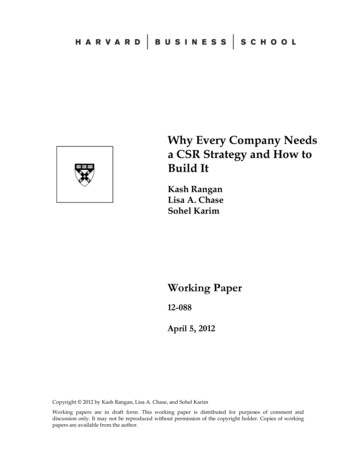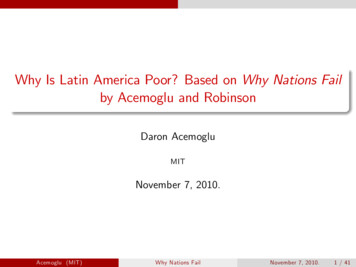
Transcription
Why Every Company Needsa CSR Strategy and How toBuild ItKash RanganLisa A. ChaseSohel KarimWorking Paper12-088April 5, 2012Copyright 2012 by Kash Rangan, Lisa A. Chase, and Sohel KarimWorking papers are in draft form. This working paper is distributed for purposes of comment anddiscussion only. It may not be reproduced without permission of the copyright holder. Copies of workingpapers are available from the author.
Why Every Company Needs a CSR Strategy and How to Build ItThe topic of corporate responsibility has been captioned under many names, includingstrategic philanthropy, corporate citizenship, social responsibility and other monikers. As thenames imply, each carries with it a certain perspective on the role of business in society.Regardless of the label, for now the dominant paradigm underlying corporate socialresponsibility or CSR is centered on the idea of creating “shared value.” The role of business,according to this model, is to create value for its shareholders but in such a way that it alsocreates value for society, manifesting itself as a win-win proposition. In one fell swoop the ideaaims to unite the critics of CSR from the left and the right, for the notion of CSR has had thedubious distinction of being criticized by both sides of the ideological spectrum.Civil society advocates question corporations’ fundamental motivations for CSR,asserting that corporate programs to fund social and environmental programs are nothing morethan public relations campaigns to boost their brand reputations, often disproportionately to theeffort itself. This dismissal of CSR resides in a fundamental distrust of a corporation’s legitimateintentions to do anything more than increase its profits. On the ideological right, critics reject therole of CSR in a capitalist society where the primary responsibility of business is seen as creatingfinancial returns for its shareholders and the larger economy. A company’s value, according tothese critics, resides entirely in its ability to generate financial wealth for its shareholders, andany social or environmental initiative that does not simultaneously create profit for a company isdeemed to be a waste of corporate resources.1 This viewpoint is founded on stark delineationsbetween the spheres of responsibility and influence of government, civil society and the businesssector. According to this argument, if each sector did what it is supposed to do, a prosperous andjust society would flourish with optimal allocation of resources.2 Further exacerbating attacksfrom the left and the right is the utter lack of metrics to evaluate the efficacy of CSR programs.For a sector driven and evaluated by its measurement of financial returns and investments, thelack of any agreed-upon measures to quantify the social or environmental return of money spenton CSR seems to run counter to corporate ethos.3Against this contentious background the idea of creating shared value has found appeal.The heart of the concept rests on the ability of a company to create private value for itself, whichin turn creates public value for society. And indeed there are examples of companies that haveaccomplished this goal. Cisco’s establishment of Cisco Academies to train networking personnelis often held up as an example of “shared value.” Nestle and its development of Milk Districts inChina, India and Pakistan is another oft-cited example, and there are many more.4In spite of its appeal, however, there is a fundamental problem with the shared value idea.The tension between business goals and social/environmental goals cannot be wished away withthe hope of co-creating private and public value. By its very nature substantive public valuecreation requires investing corporate resources for a payoff that is both distant and uncertain.This makes shared value very much a top-down concept. Only the CEO or the executivecommittee will have the authority to conceive and sanction such initiatives. Yet the reality is thatmost CSR functions in companies are staffed by managers who are a rank below the executivecommittee level. We have talked to hundreds of these managers, and they feel disconnected fromthe shared value concept because they perceive it as sitting above their “pay grade.” As for the1
CEOs, given the pressures of business and meeting their “numbers,” shared value is naturally notat the top of their agenda, except for a handful of committed CEOs. The examples of Cisco andNestle reveal yet another limitation. Interestingly, both companies are leaders in their respectivebusinesses and as a result improvements they make to the societal infrastructure are also likely tobenefit them disproportionately. It would not be economically worthwhile, however, for asmaller player to do what the market leaders have done for fear of competitors taking a free-rideon their public investments. The kind of shared value a smaller player would seek would have tobe narrower and more self-directed, and effective only if the company is in a position to capturea major proportion of the value it creates. Thus there will hardly be any public value creationexcept for what the company does for its proprietary networks, such as supply chain anddistribution partners. These third party players will not be able to benefit from the company’sactions as stand-alone public players, but only as part of the company’s mutually beneficialecosystem. This is not the lofty vision of “shared value” that its proponents likely had in mind.In this paper we offer a pragmatic alternative vision for CSR with a view towardsdeveloping its practice in an evolutionary way. The authors’ extensive experience working withCSR practitioners convinces us that attempting to unify diverse CSR initiatives under a sharedvalue framework does not reflect the reality of CSR practice for a majority of businesses. CSRexecutives oversee a variety of social initiatives that may or may not directly contribute to acompany’s business goals. His/her role then is to achieve the difficult task of reconciling thevarious programs, quantifying their benefits, or at least sketching a logical connection to thebusiness, and securing the support of his or her business line counterparts. This role whenperformed well, would lead to the development of a CSR strategy for the company.CSR is Here to StayThe fact remains that, despite its critics, a rapidly growing number of companies in theworld practice some form of CSR. At last count, more than 3,500 companies were part of theGlobal Reporting Initiative, and had issued more than eight thousand environmental and socialsustainability reports.5 This number was less than 1400 just two years ago. In a 2008 Economistonline survey of 1,192 global executives, an estimated 55 percent reported that their companiesgave high priority to corporate responsibility. The number was projected to increase to 70percent by 2010, 6 demonstrating that a rapidly increasing number of companies across the globeare committed to CSR practice, and many more are increasingly entering the fray. Yet many ofthem do not have either a strategic approach or a lofty “shared value” conception of CSR. Ratherthey practice an ad-hoc version of corporate social responsibility that has usually evolvedthrough a variety of paths for a myriad of reasons.For example, one cannot underestimate the philanthropic motivations of employees as aCSR driver. Individual employees who already are engaged with their local communities oftenwill carry their pet causes to work, where a small donation here, and a little volunteer activitythere can soon create a momentum of its own that may take the shape of formalized support fromthe organization. Annual matching gifts are an easy way for an employer to support itsemployees’ motivations, while in other cases corporate support for employee causes maydevelop into something more focused and significant. To ensure that its operations have supportand a social license to operate from the local communities where they reside, the company’s2
managers may accede to charitable requests for community organizations within a set budgetlimit. Often when there is enough lee-way in the budget, the same local managers at theirdiscretion may direct funds to causes they care about, and which could have a positive influenceon their business operations. Many times, however, these initiatives don’t have any directbenefits to the business, but simply serve to enhance the company’s image and social standing inthe community.Another critical driver of CSR practice comes from corporate leaders. Corporations arenot monolithic entities, but organizations governed and lead by individuals and anchored in thesocieties in which they conduct their businesses. Corporate social responsibility schemes reflectthe human side of corporations, and their leaders’ personal commitments to contribute to thecommunity and society of which they are a part.7 Some corporate leaders feel a compulsion toserve their community or society in the course of their business practice, while others sponsorCSR programs to express and support their employees’ community values. Additionally,business leaders are well aware of the need to gain goodwill and society’s permission to operatewithin the communities where they conduct their business. Civil society organizations (CSOs)and nongovernmental institutions can often be a compelling force pushing corporations to attendto the social and environmental impacts of their business operations.8 No doubt some of themotivators for CSR are reactive, in response to community concerns. Nonetheless, once they arelaunched, often there is a constituency of supporters within a company that will demand itscontinuation.Compared to public companies, privately owned companies, both large and small, oftenhave much greater freedom in allocating their charitable dollars in line with the philanthropicinclinations of their controlling owners, regardless of how well or poorly the donations alignwith the companies’ business purpose. As a company grows larger it may seek a moredisciplined approach to its philanthropic activities, either through the creation of a formalfoundation to oversee the company’s charitable contributions or the creation of a “communityaffairs” liaison within the company to direct its activities. The owners and protagonists mayattempt to move philanthropy to a more strategic platform, creating a closer alignment withbusiness goals.As a result of such diverse motivations, corporate initiatives falling under the CSRumbrella encompass a broad scope, including corporate funding of community activities, grantsfor nonprofits/NGOs, environmental sustainability programs to reduce energy and resource use,and comprehensive efforts to remake a business’s entire value chain. CSR is inherently organic,as companies both respond to societal expectations and define CSR in terms of their ownorganizational and social motives for philanthropic giving and civic engagement. Manyinitiatives originate in the field or from the staff in a bottom up approach, while some are topdown initiatives from executive management.9 Some programs may have compelling businesslogic, but they may have little or no connection to the corporation’s business strategy or corecompetencies.10In order to mold this disparate range of practices into effective CSR, chief executivesneed to be more concerned with how to bring coherence to their CSR programs, and how tomeasure and report on the social and environmental value of their initiatives in an authentic3
fashion. After all, much of Milton Friedman’s oft-cited critique of “socially responsiblecorporations” is founded on the daunting challenge for corporate executives of deciding whereand how to spend corporate profits in a way that can contribute to social or environmentalvalue.11 This seems not a dismissal of CSR, but a clarion call for more robust and strategicallydesigned CSR initiatives which have real meat. Incongruities in CSR practice and the absence ofstandards for measuring and reporting on CSR should neither be a reason for corporations’benign tolerance of CSR programs, nor a reason to abandon them. They represent an opportunityfor companies to dramatically improve strategic CSR practice.Every Company Needs a CSR StrategyGiven the enormous tug towards CSR, without the accompanying discipline, thequestion for corporations is not whether to engage in CSR, but what the best way forward is forcrafting CSR programs that reflect a company’s business values, while addressing social,humanitarian and environmental challenges. Considering the many disparate drivers of CSRwithin a company, and the many different motivations underlying the various initiatives, we findit naïve to expect a company to somehow weave all this together and incorporate it as part ofbusiness strategy. Some CSR programs will lend themselves to such an exercise, but many otherelements will not. Instead of attempting that futile exercise, our call is to bring discipline andstructure to the many fragmented components. Its components will in some cases support thecore strategy and in some others may appear adjacent and discretionary. The fundamentalproblem with CSR practice is that companies usually don’t have a CSR strategy, but rathernumerous disparate CSR programs and initiatives.12 This paper attempts to bring these disparatepieces together in the form of a coherent strategy. We argue that every corporation should have aCSR strategy that unifies the diverse range of a company’s philanthropic giving, supply chain,“cause” marketing, and system level initiatives all under one umbrella. Note, however, that ournotion of CSR Strategy does not equate to a complete absorption into the company’s corebusiness strategy.In this spirit we advance the platform of three theatres of CSR, which is a descriptiveframework from which strategic implications will be drawn. Evaluating and classifying CSRpractice within these three theatres accommodates the wide range of activities business leadersdescribe as CSR and provides a framework to devise a comprehensive CSR strategy thatintegrate all of these efforts. The three compartments are not water-tight; we do not offer auniversal address for each CSR activity. Rather it depends on the origins of a particular CSRinitiative, and its social or environmental purpose as defined by an individual organization. Thedistinguishing feature of each theatre is the unique logic of how programs in the respectivedomains are intended to address a firm’s CSR priorities.The Primary Theatres of CSR PracticeIn Theatre 1 we group activities that are primarily motivated by charitable instincts, eventhough they may have potential business benefits. Theatre 2 represents CSR activities that are4
symbiotic and intended to benefit the company’s bottom line, as well as the environmental orsocial impacts of one or more of their value chain partners, including the supply chain,distribution channels, or production operations. In Theatre 3 we classify programs that are aimedat fundamentally changing the business’s ecosystem. This transformation is intended to enhancethe company’s long term business position, but frequently entails short-terms risks in order tocreate societal value. Our analysis suggests that most companies rarely coordinate among thethree theatres, let alone recognize the contributions of each to societal well-being.While this paper develops a framework for the three theatres in which corporationspractice CSR, we do not assert that a company needs to be involved in initiatives within all three.Neither do we imply that a company must sequentially evolve from one theatre to the other.Rather we argue that every corporation should maximize its CSR effectiveness within the theatreor theatres it participates in and devise a coherent strategy for its CSR programs, whether in oneor all three domains of practice. After all, it’s neither practical nor logical for every company toengage in the same “brand” of CSR. While a manufacturing company may have richopportunities to reduce the environmental impact of its supply chain and production operations, afinancial services company would be hard pressed to devise aggressive social or environmentalsupply chain programs. A global financial services institution may, however, have vast resourcesand societal influence to launch significant initiatives aimed at financial inclusion and literacy.Likewise, a corporation’s social or environmental impact will vary widely depending on itsindustry and its geographic reach. The types of CSR programs a company focuses on should bedetermined by its core competencies and institutional capacity, and its ability to excel in eitherphilanthropic, value chain or transformative ecosystem CSR efforts. Every CSR theatre isimportant to addressing social and environmental problems, either at a local or global level, andnot all CSR programs should or will have an immediate business bottom-line goal.Theatre 1: Philanthropic GivingThe first CSR theatre focuses on philanthropy, either in the form of direct funding tononprofit and community service organizations, employee community service projects, or inkind donations of products and services to nonprofits and underserved populations. Corporatephilanthropy may be characterized as the “soul” of a company, expressing the social andenvironmental priorities of its founders, executive management and employees, exclusive of anyprofit or direct benefit to the company. Within privately held companies, the values of thecontrolling owners often determine the company’s philanthropic priorities, while charitableendeavors for publicly held companies may be influenced by boards of directors and executivemanagement. Within this theatre a business engages in CSR because it is a good thing to do,motivated by the logic that since the corporation is an integral part of society it has an obligationto contribute to community needs.13 While it may be challenging for corporate leaders to make acoherent argument for how philanthropic activities contribute to a company’s business strategy,in general these activities enhance a firm’s reputation in the local community and provide adegree of insulation from unanticipated risks.14Philanthropic funding is frequently provided directly or through corporate foundationsthat exist separately from the corporate entity. The Coca-Cola Company (Coca-Cola), for5
example, contributes 88.1 million annually to a variety of environmental, educational andhumanitarian organizations through The Coca-Cola Company and The Coca-Cola Foundation.15Other examples of in-kind giving include IBM’s computer donations through its global KidSmartEarly Learning program16 and Microsoft’s donation of almost 300 million in software productsto nongovernmental organizations (NGOs) across the globe.17 Similar to corporate cash funding,in-kind donations provide important, and often critical, goods and services to nonprofitorganizations and needy populations. Both types of philanthropic giving tend to reflect acorporation’s core competencies and business priorities, as illustrated by IBM’s and Microsoft’stechnology donations.The larger a corporation’s size and revenues, the greater the diversity of decision makersand the more fragmented its philanthropic activity may become. Whether privately or publiclyheld, as a business grows and expands into national and global markets, its organizationalstructure tends to become more complex. This may result from the company’s integration intonew cultural and socioeconomic environments, as well as the geographic dispersion ofexecutives in various product areas and management functions. The addition of executivecommittee members and boards of directors creates multiple corporate decision makers who maybe personally committed to a wide range of charitable social and environmental priorities. Theseexecutive leaders in turn are responsibl
Why Every Company Needs a CSR Strategy and How to Build It The topic of corporate responsibility has been captioned under many names, including strategic philanthropy, corporate citizenship, social responsibility and other monikers. As the names imply, each carries with it







![Shareholders’ Agreement of [Company name] company. 1 .](/img/1/startup-founders-sha-sample.jpg)



